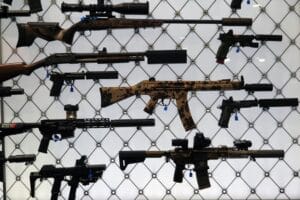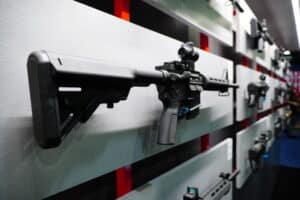The Supreme Court has now declined to intervene in two different suits against New York’s latest gun restrictions. Doing so would have short-circuited the Second Circuit’s procedures, and deciding not to get involved now doesn’t mean the Court won’t eventually take up one or both cases. Still, it’s not the outcome gun-rights advocates were hoping for.
So, I take a look at what we should make of the Supreme Court’s reluctance to jump into these cases on an emergency basis.
We saw a state judge block the Illinois AR-15 ban on Friday. But the legal arena is just one of the areas state lawmakers are facing a tough fight over the law. Contributing Writer Jake Fogleman examines the confrontation between local officials backing “Second Amendment Sanctuaries” by promising not to enforce the law and the legislators who passed the expansive prohibition.
Plus, pistol brace inventor Alex Bosco joins the podcast to react to the ATF’s sweeping new ban.
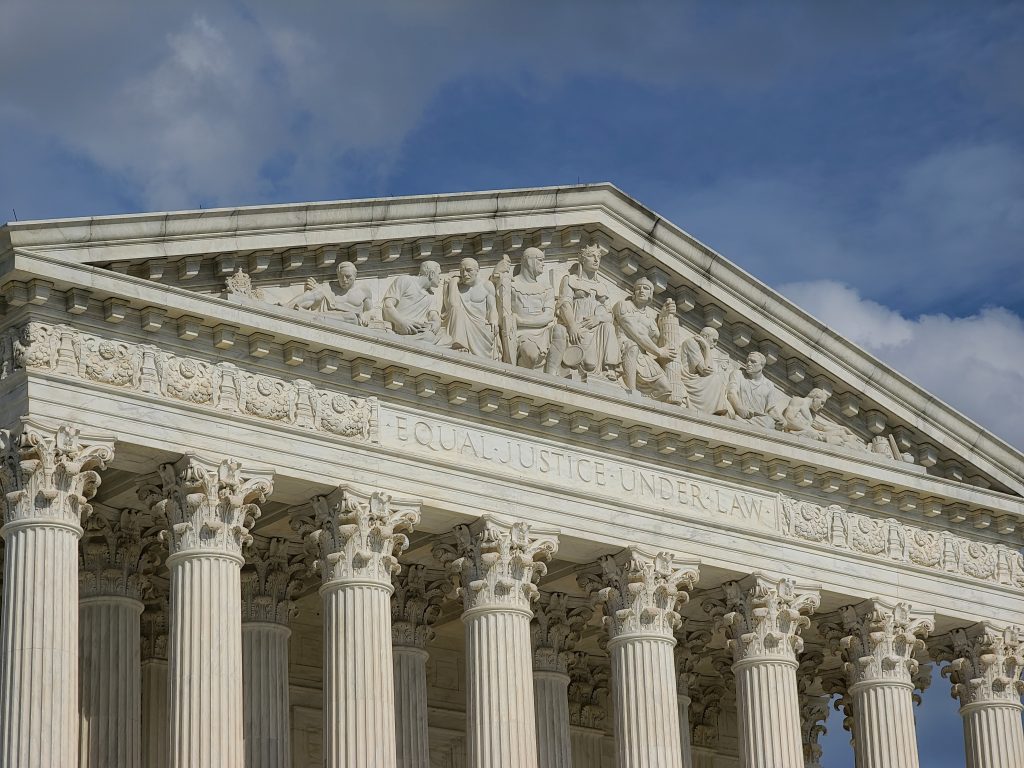
Analysis: Why isn’t the Supreme Court Intervening in the New York Gun-Carry Cases? [Member Exclusive]
By Stephen Gutowski
It’s understandable that gun-rights advocates are disappointed by the Supreme Court’s recent decision not to get involved in two cases against New York’s latest gun restrictions, but they shouldn’t be surprised or particularly concerned by it.
On Thursday, the Court declined to issue an emergency order sidestepping the Second Circuit and put a stay on enforcement of New York’s new gun dealer security requirements and ammunition background check system. Plaintiffs in Gazzola v. Hochul argued the law’s implementation could cause them to shutter their businesses, and they asked the justices to block it while their case makes its way through the legal process. So, when the Court decided not to act, the plaintiffs were understandably dismayed.
“We are disappointed that not one of the nine justices saw fit to grant the plaintiffs some stay of enforcement of the new laws against them,” Paloma Capanna, a lawyer for the plaintiffs, told Fox News Digital. “We are challenging the ability of the state of New York to target dealers in firearms in the lawful stream of commerce, to put them out of business, which is what the new laws will do. So it really was unfortunate to see that we couldn’t get any emergency temporary injunction against those laws.”
That came just over a week after the Court decided not to intervene in Antonyuk v. Nigrelli, which challenges New York’s expansive post-Bruen gun-carry restrictions. In that case, plaintiffs wanted the Court to lift a Second Circuit stay against a district judge’s ruling that the restrictions are unconstitutional. But the Court didn’t do that either.
It’s easy to see why this might cause consternation among gun owners, especially in the wake of the Supreme Court issuing the landmark Second Amendment ruling in New York State Rifle and Pistol Association v. Bruen just six months ago. And New York’s Bruen response law was passed to rebuke that very ruling. Most of the controversial provisions appear plainly unconstitutional under the standard set in Bruen, as several lower court judges have already found.
The cases against many of the provisions look like they may be slam dunks. At the very least, they seem to justify delaying enforcement of the law while the legal fight is worked out.
However, that’s not usually how the Supreme Court operates. Even beyond the Second Amendment, the Court often doesn’t follow up landmark rulings with further intervention on the topic. At least not right away.
As Cam Edwards at Bearing Arms notes, even in some of the most famous rulings in Supreme Court history, it took a few years for the issue to get fully sorted out. He pointed to 1954’s Brown v. Board of Education as an example. For years after the Supreme Court ruled racial segregation in schools was unconstitutional, there were holdouts at the local level.
Prince Edward County, Virginia, kept its schools segregated for six years after the case was decided. Then it shuttered its public schools altogether rather than integrate for four years after that. The Court did not intervene in the legal case against the district during that decade.
The Court generally wants lower courts to develop a full record in a follow-up case that attempts to interpret its new standard of review before it weighs in. In fact, given they can only take so many cases each session, the Court usually likes to wait for a significant disagreement on how to apply a standard occurs between the appeals courts before it intervenes.
So, the delay isn’t out of the ordinary. And it also doesn’t provide much evidence the Court won’t eventually step in to strike down New York’s law.
In 1964, the Court took up a case against Prince Edward County’s segregation policies, ruling 7-2 against the county. The delayed intervention was clearly not because the Court felt sympathy toward local officials’ legal arguments.
Of course, the decade that elapsed between the landmark Heller and MacDonald decisions and Bruen is another Second-Amendment-specific example of a delay not foreshadowing a change of position. Bruen expanded on the Court’s reading of gun-rights protections rather than reversing them.
There are good reasons to think the same could happen with New York’s gun restrictions and that the Court may not wait nearly as long to get involved. Namely, Justices Samuel Alito and Clarence Thomas explicitly said the Court decided not to jump into Antonyuk out of deference to the Second Circuit’s process for considering cases.
“I understand the Court’s denial today to reflect respect for the Second Circuit’s procedures in managing its own docket, rather than expressing any view on the merits of the case,” Alito wrote.
They went a step further and called the lower court ruling that found New York’s gun-carry restrictions unconstitutional “thorough” and warned the Second Circuit to explain why it placed a stay on that ruling sooner rather than later.
“With one exception, the Second Circuit issued a stay of the injunction in full, and in doing so did not provide any explanation for its ruling,” Alito wrote. “In parallel cases presenting related issues, the Second Circuit has likewise issued unreasoned summary stay orders, but in those cases it has ordered expedited briefing.”
He also noted the law raises important legal questions that haven’t been fully examined.
“The New York law at issue in this application presents novel and serious questions under both the First and the Second Amendments,” Alito wrote. “The District Court found, in a thorough opinion, that the applicants were likely to succeed on a number of their claims, and it issued a preliminary injunction as to twelve provisions of the challenged law.”
Alito even encouraged the plaintiffs to ask the Court to intervene again if the Second Circuit doesn’t move quickly enough.
So, while the Court isn’t moving as fast as gun-rights advocates might want, it isn’t doing anything out of the ordinary. And there’s reason to think the Court might not only move on these cases faster than normal but that it is leaning against the gun restrictions.
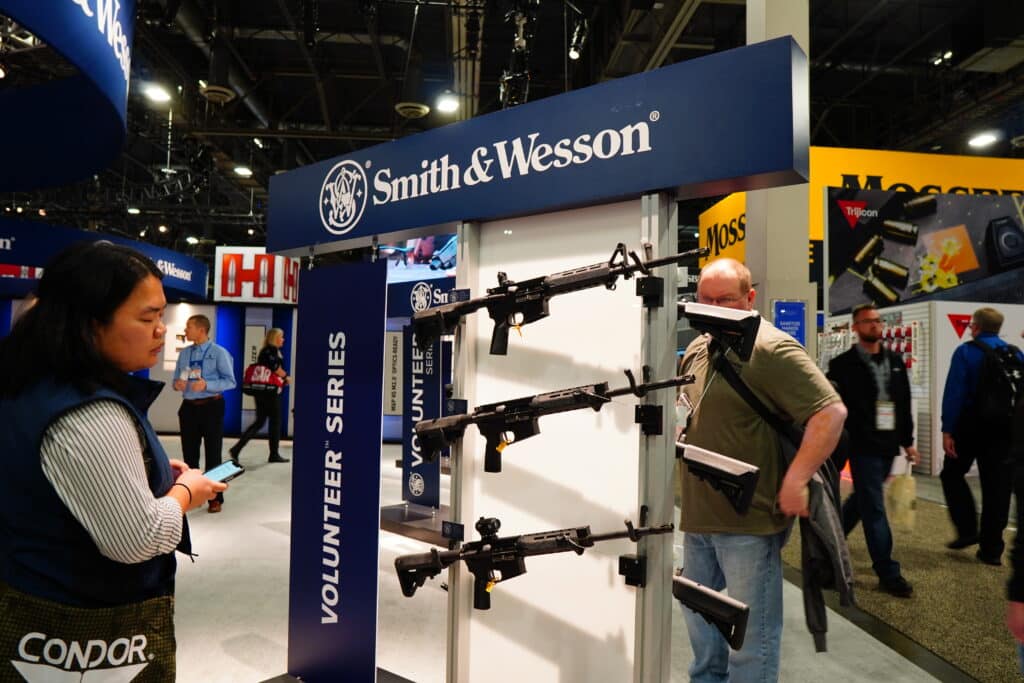
State Judge Blocks Illinois ‘Assault Weapons’ Ban
By Stephen Gutowski
A state judge has found Illinois’ new ban on AR-15s and similar firearms violates residents’ constitutional rights.
Judge Joshua Morrison granted a temporary restraining order to the plaintiffs in Accuracy Firearms v. Pritzker on Friday. He found the state’s ban on so-called assault weapons, including popular guns like the AR-15 and AK-47, violates several sections of the state constitution and also contradicts the latest gun-rights ruling from the Supreme Court of the United States (SCOTUS).
“The Court finds the Plaintiffs have shown a likelihood of success in relation to the equal protection clause of the Illinois Constitution and that the Defendant’s use of criteria, especially those that is not evenly applied violates the face of the Supreme Court’s findings in New York State Rifle Association, Inc v. Bruen [SIC],” Judge Morrison wrote in his decision.
He ruled the law represents an ongoing danger to the Illinois residents who filed the case.
“Plaintiffs are being immediately and irreparably harmed each day in which their fundamental right to bear arms is being denied and that this harm is continuing in nature,” he wrote.
While the ruling is limited to the 866 plaintiffs who filed the case, it is a bad start for one of the first new statewide assault weapons bans to pass in over two decades. It deals an early blow to the hopes of the ban’s supporters who are running up against the most hostile legal environment for the laws since they were first created in the late 1980s. And a pending federal case against the law could bring further trouble.
That’s because the Bruen decision casts new doubt on the legality of the modern bans, which don’t have a historical analogue from the founding era as required under the test for modern gun laws established in the case. Additionally, several other assault weapons bans have already been blocked by judges in the wake of Bruen, including an Obama appointee and a Biden appointee. And the Supreme Court has vacated a lower court ruling in Bianchi v. Frosh upholding Maryland’s ban with instructions to retry the case under the new test.
The ruling and associated legal trouble are just one of several setbacks for backers of the ban who were already contending with pledges for mass non-compliance from gun-rights activists and local sheriffs alike. Dozens of local officials have pledged not to enforce the ban’s registration requirements against residents that purchased their now-banned guns and ammunition magazines. Governor J.B. Pritzker (D.) has vowed to punish sheriffs who decline to enforce the law he backed and use state resources to ensure residents don’t evade the ban, but he has limited options for following through on those threats.
Judge Morrison ruled passage of the ban violated multiple procedural requirements under the Illinois constitution, including a rule requiring the bill to be read on three different days before passage. But he also found it violated the state constitution’s due process and equal protection clauses. He argued the way the legislature exempted certain groups from the effects of the ban was inconsistent and illogical. And he found banning low-recoil firearms that are often used by disabled people for self-defense, such as the AR-15, represented a violation of that protected group’s rights.
“The Court cannot find it logical that a warden of a prison (included in the exempted category) is necessarily better trained or more experienced in the handling Of weapons than retired military personnel (not included in the exempted category),” Judge Morrison wrote. “It also does not follow that a member of the National Guard would be Ies well or experienced in handling a firearm when they are not on active duty compared to when they are. Further, other rational and logical exemptions have been excluded, such as a person in a wheelchair who cannot use a shotgun due to concerns, thus discriminating against a class.”
He said the state was unable to justify the need for the ban or the exceptions to it.
“Due to the lack of compliance of the Defendants, the Court is left with nothing to conclude what might be the compelling public purpose of this legislation,” he wrote. “In oral arguments, the Defendants suggested that the goal of the legislation was to reduce firearms deaths and mass shooting casualties; however, they offered no evidence that the individuals in their newly created class on training and experience were any more or less likely to commit these crimes, nor did they provide evidence that the individuals excluded from this class were more likely to commit crimes.”
Governor Pritzker decried the ruling. He said it was “not surprising” but “disappointing.”
“[I]t is the initial result we’ve seen in many cases brought by plaintiffs whose goal is to advance ideology over public safety,” he said in a statement. “We are well aware that this is only the first step in defending this important legislation.”
Pritker said he remains “confident that the courts will uphold the constitutionality of Illinois’ law,” which he said “takes weapons of war and mass destruction off the street while allowing law-abiding gun owners to retain their collections.”
Judge Morrison said the ban may have further constitutional defects beyond the ones he ruled on in his order.
“[T]the U.S. Supreme Court recently found, in New York State Rifle Association, Inc. v. Bruen, that the State of New York violated the Constitution when requiring ‘proper cause’ in order to obtain a license to carry a gun,” he wrote. “As requirements for possession of a weapon in the home is generally and necessarily less restrictive than carrying a weapon outside of the home; it follows that ‘proper cause’ would be unallowable for possession as well. As training and experience are being used by the to justify who can and cannot possess these it is an example of a use of ‘proper cause’ and is therefore Unconstitutional.”
He scheduled a preliminary injuction hearing for February 1st, 2023.
Podcast: Pistol Brace Inventor Alex Bosco on the ATF’s New Ban [Member Early Access]
By Stephen Gutowski
This week, we’re diving into the details of the ATF’s pistol brace ban.
That’s why we have pistol brace inventor and SB Tactical owner Alex Bosco on the show. He gave his view on how many guns will be affected by the ban, whether any braced guns avoid the prohibition, and the legal case he’s building against it.
Bosco said he believes there are at least 10 million braces in circulation despite the ATF’s claim the number is closer to 3 million. He said the new rule appears to effectively reclassify all braced guns with rifled barrels shorter than 16 inches long as short-barrel rifles that require registration under the National Firearms Act. That means millions of Americans will have to either dismantle, turn in, or register their braced guns to avoid potential federal felony charges.
But he said the problem goes deeper than that because some braced guns won’t be eligible for registration or dismantling. Bosco noted the ATF said many imported braced guns sold as pistols could not legally be converted to rifles under federal law. That means they must be destroyed or turned in to the ATF.
Bosco argued this was one of several legal weaknesses in the ban that he plans to sue over with the backing of the National Rifle Association, which has committed to helping fund a challenge. The Fifth Circuit’s recent ruling against the Trump-era bumpstock ban provides a good template for how to beat the ATF’s latest regulation, and nearly every major gun-rights group is filing suit against the pistol brace ban. Bosco said he is hopeful they will prevail.
Plus, Contributing Writer Jake Fogleman and I talk about local law enforcement resisting the Illinois “assault weapons” ban, as well as my trip to SHOT Show in Las Vegas, which featured a speech from ATF Director Steve Dettelbach.
You can listen to the show on your favorite podcasting app or by clicking here. Video of the episode is available on our YouTube channel. As always, Reload Members get access on Sunday, and the show goes public on Monday.
Come on the Podcast
One of the many perks of a Reload membership is the opportunity to appear on the podcast. We’ve had a lot of people on the show from all kinds of backgrounds. It’s one of my favorite segments since it gives us all a better insight into the community that makes this publication possible. If you want to come on the show, just reply to this email and let me know!
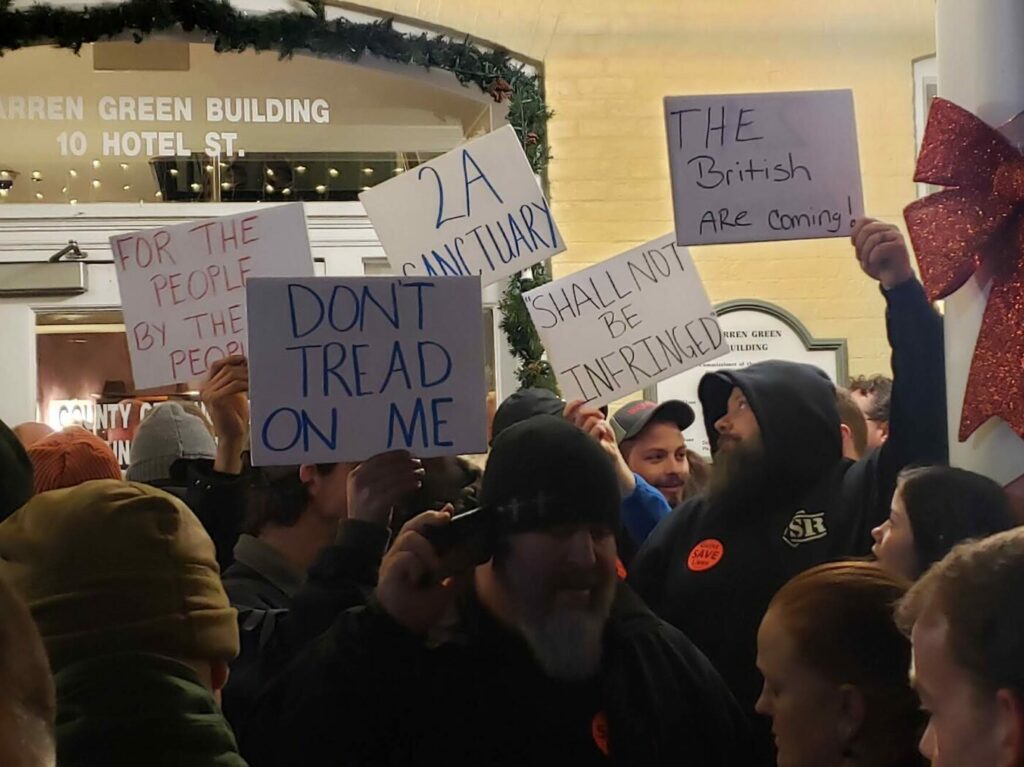
Analysis: Illinois Sheriffs’ Resistance to AR-15 Ban Latest Frontier for Second Amendment Sanctuary Movement [Member Exclusive]
By Jake Fogleman
In the state often credited with kicking off the nationwide movement, so-called Second Amendment Sanctuaries are being put to their most significant test yet.
Shortly after Illinois Governor J.B. Pritzker (D.) signed a bill banning “assault weapons” and certain ammunition magazines into law last week. Illinois gun owners have 300 days to register or otherwise dispose of the thousands of different models of guns affected by the ban. If they don’t, they could face serious criminal charges.
However, the actions of local officials across the state are calling that possibility into question. Many have begun to mobilize in opposition to enforcing the law. Sheriffs and State’s Attorneys of more than 80 Illinois counties have released statements decrying the law as “unconstitutional.” Most have publicly declared that they refuse to enforce it against otherwise law-abiding citizens.
“Until further direction from our courts, the Effingham County Sheriff’s Office will not expend the resources of Effingham County to ensure law-abiding gun owners are registering their firearms with the State, or arresting, otherwise law-abiding individuals, solely for their non-compliance with HB5471,” Effingham County Sheriff Paul Kuhns said in a public release.
“My office will exercise strict prosecutorial discretion in circumstances relating to enforcement of House Bill 5471, ensuring that the clearly-defined Second Amendment rights of our citizens remain undiminished,” Effingham County State’s Attorney Aaron Jones added. “While my office remains committed to protecting the citizens of Effingham County by prosecuting violent crimes, I have no intention of turning otherwise law-abiding citizens into convicted felons solely due to non-compliance with House Bill 5471.”
The sentiment was echoed in jurisdictions around the state with model language provided by the Illinois Sheriffs Association. Nine in 10 of the state’s sheriffs have now publicly declared their intention to disregard the law, according to the Associated Press. The sheer number of prosecutors and sheriffs who have come out against enforcing the new ban represents a new high water mark for the Second Amendment Sanctuary movement. That’s fitting for a trend that has its roots in none other than Effingham County, Illinois.
Resistance to gun control from higher up in the government has existed in some form for decades. The successful challenge of the Brady Act’s initial requirement that local law enforcement use their resources to conduct background checks on gun buyers in 1997’s Printz v. U.S. is one early success in the power struggle. Beginning in the mid-2000s and through the early 2010s, a handful of deep red states and localities around the country even passed resolutions suggesting that they wouldn’t obey gun laws they viewed as unconstitutional–though they were often primarily symbolic measures that have never been put to a significant test.
Those earlier efforts began to crystalize into the modern sanctuary movement starting with Pritzker’s 2018 election. Effingham County officials, alarmed by his win and the possibility of an assault weapons ban, passed the first resolution credited with coining the term “sanctuary” as applied to the Second Amendment. The resolution, which quickly spread to 70 additional counties across Illinois and later other states like Virginia, was a simple declaration that local officials would view any of the gun-control laws then under consideration by the legislature as unconstitutional.
“We’re just stealing the language that sanctuary cities use,” Bryan Kibler, former Effingham County State’s Attorney, told the Associated Press in reference to the immigration “sanctuary” movement at the time. “We wanted to get across that our Second Amendment rights are slowly being stripped away.”
Now, faced with a new set of gun-control measures, a similar dynamic is at play.
But unlike those previous resolutions, which predominately surfaced ad hoc wherever new gun-control measures were a possibility, the current crop of non-compliance declarations are being announced in response to a law that has passed. That creates a new paradigm testing the mettle of officials on both sides. Without local law enforcement support and few options to force their hand, backers of the ban are left without many options. The state’s gun owners could very well decide to disregard the registration requirement, and local law enforcement may well follow through on their promise not to bother them.
That has happened before.
Following the 2013 passage of the SAFE Act in New York, the refusal of some sheriffs to enforce its ban on certain guns and magazines coincided with widespread non-compliance. The most recent data suggests only about four percent of the guns required to be registered under the SAFE Act have actually been registered.
“It’s not that they aren’t aware of the law,” Paloma Capanna, a firearms lawyer who obtained the registration data, told Hudson Valley One in 2019. “The lack of registration is a massive act of civil disobedience by gun owners statewide.”
Since ninety percent of Illinois’ sheriffs are vowing to look the other way on this latest ban, it’s hard to see how the results don’t end up looking similar in the Land of Lincoln.
Of course, it remains to be seen how resolved the Illinois sheriffs are in refusing to enforce the gun ban and corresponding registry requirement. The rapid groundswell of opposition has already provoked a backlash from many of the state’s top Democratic lawmakers, including Governor Pritzker.
He has repeatedly suggested that the defiant sheriffs are “violating their oaths of office” and has threatened to fire those that refuse to enforce the ban. However, it does not appear that he has the power to remove duly-elected sheriffs from office under Illinois law.
Even if he can’t directly remove the local officials, Pritzker may hope to sway or replace them by other means. Or bypass them altogether.
“It’s our state police and law enforcement across the state that will, in fact, enforce this law, and these outlier sheriffs will comply or, frankly, they’ll have to answer to the voters,” Pritzker told NBC 5.
It’s possible the political pressure could wear some sheriffs down and cause them to reverse course. Or some might have misread what their constituents want and get an earful from residents clamoring to see a gun ban enforced. Pritzer could also prioritize using state police resources to try and enforce the ban on their own, though that would be a very tall order without local support.
If not, the rapid and organized adoption of non-enforcement policies across broad swaths of Illinois in response to a gun ban and registry requirement may become the biggest success story of the Second Amendment Sanctuary movement to date.
That’s it for now.
I’ll talk to you all again soon.
Thanks,
Stephen Gutowski
Founder
The Reload




